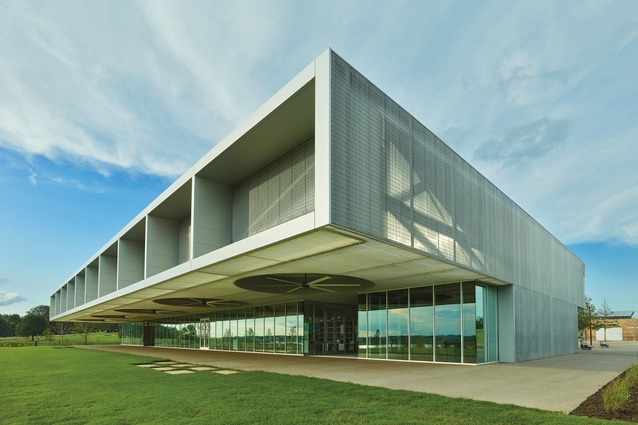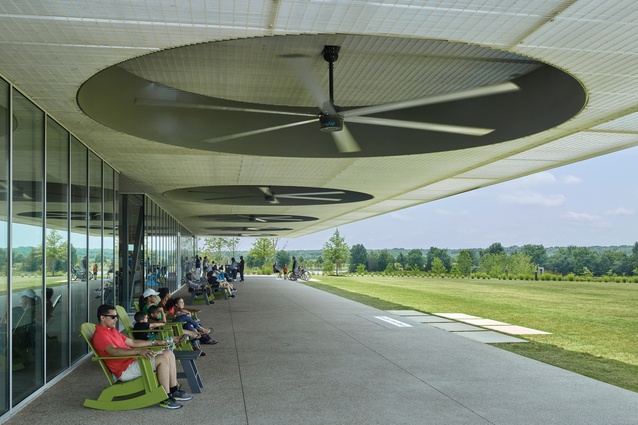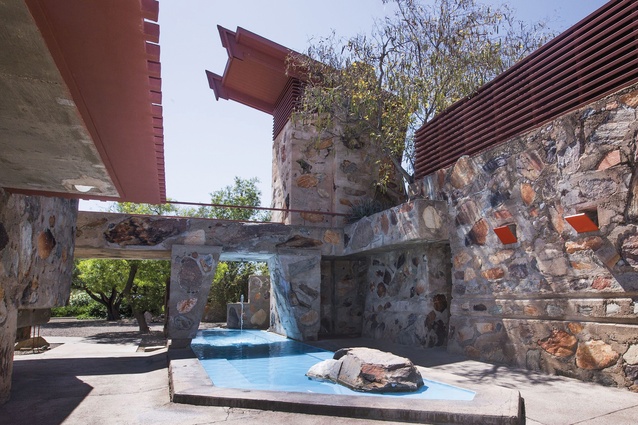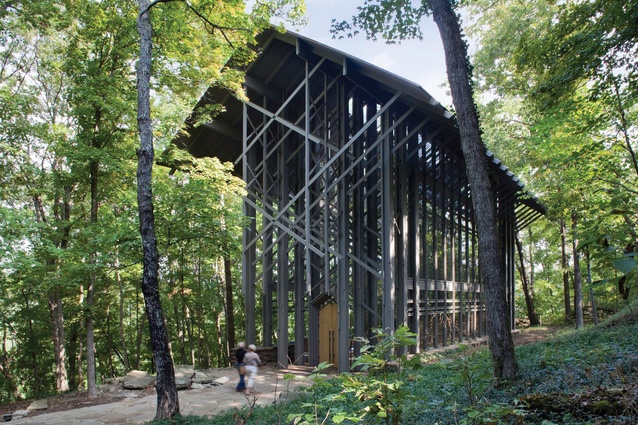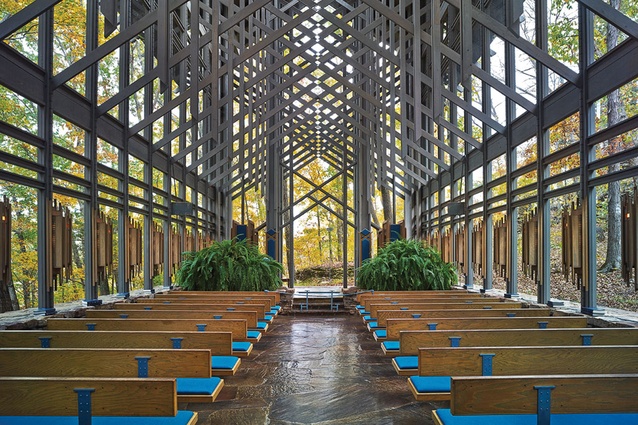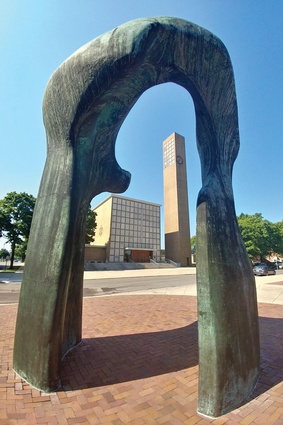Essay from America
The Americans may not know who we are or where in the world we reside but, on a recent lecture tour of heartland USA, Jeremy Smith finds the topic of change provides common ground for architectural debate.
America is big. It’s the land of more: a Grand Central Station. New Zealand, in comparison, is the last stop on the subway. While we think nothing of travelling into the city, those in the city rarely ride out past the suburbs. We are an island and look outwards. America thinks as a continent and looks inwards.
To be invited from way down here to give a series of lectures at some of heartland America’s best architecture schools presented the opportunity for a somewhat daunting step into the well known: Taliesin West, the Fay Jones School of Architecture and Design in Arkansas, Kansas State University, Mississippi State University, Auburn University’s Rural Studio, the University of Kentucky, Indiana University at Columbus and Carnegie Mellon University, and a swansong at the The Architectural League of New York on Broadway.
What did they know about us? I started by warning that I might sound a bit like Lorde or perhaps a hobbit, but I would endeavour to use as many “Y’all”s as I could to ease the translation. I showed a New Zealand-less map of the world. Had anyone been to New Zealand? Who actually knew where we are? The occasional raised hand identified that Middle America knows very little about us beyond Middle-Earth fame. “It’s beautiful and somewhere near Australia… perhaps?” We really are way down under.
From so far away, I suggested we could talk about change. Our landscape isn’t like Australia’s. It’s not an ancient continent where you can sit lightly on the land as Glen Murcutt demonstrates.1 Think of our plate boundaries moving at the same speed at which fingernails grow, of how we have turned forest to pasture with unparalleled speed or even how quickly our supermarkets have become plastic bag-free. Our landscape is shifting and, way down here, we need to hold on.
The lecture traced our architectural practice approach of participating with existing landscapes before generating new contexts as shown by an exhibition at the Prague International Architecture Festival, doctoral research and studio teaching at the University of Auckland, and recent residential and public work. Key to it all is our Bach with Two Roofs project and a landscape turned from forest to clearing by a cyclone.
This progression shows how the Bach with Two Roofs responded to a changing landscape. 01: Original bach. 02: Damange to the treescape from a cyclone. 03: The original bach sitting within the depleted landscape. 04: The bach as it is now, with renovations after the cyclone. 05: A projection of how the new bach might fit with tree growth in the future.
After the clean-up, we found the buildings needed more than repair – they needed refinishing, for, without the moderation of the forest, the sun was hotter and the wind stronger. The cyclone had effectively sped up time and our buildings could no longer stay the same. They had lost their fit. Yet, they couldn’t remain unchanged in the future either. New trees were growing and, to participate, we needed to prepare the buildings to be iteratively refinished in a landscape now shifting from clearing to forest.
Yet, we all assume and, in fact, are taught that we can control the landscape. We, the profession, learn a methodology to finish the landscape repeatedly so we don’t need to change our buildings.
My analogy to America is the Farnsworth House. Mies’ infamous quote, that nature looks better from inside the Farnsworth House than it does from outside,2 relies on him controlling the landscape. If he doesn’t and a forest grows, then the fit between building and the landscape can’t be equally good before and after. Mies must “mow the lawn” and repeatedly finish the landscape so he doesn’t need to change his building.
With the Farnsworth House now increasingly flooding and debate continuing over whether to move it to higher ground,3 I suggested that, in these shifting landscapes, it is not the landscape that needs to be repeatedly finished, but the buildings. Had Mies known these floods were coming, then he surely would have designed the building to change. Whether in New Zealand or America, in built or unbuilt landscapes, our environments simply aren’t able to be controlled as was once believed. Our practice is now learning to avoid finishing buildings.
A tough sell to America, you might say. Perhaps there was a ‘national state of emergency’ in place, with Trumpian walls to be built and landscapes controlled. After two days staying at Taliesin West amongst Frank Lloyd Wright’s stone plinths, sidestepping cacti and the never-ending lines of architectural tourists while stooping under ceilings designed for the 5 foot 5, came the questions.
Critic Aaron Betsky started the process of placing our work into America. The Bach with Two Roofs’ iterative approach to life in the forest wasn’t like the Shingle Style4 documented by Vincent Scully of an American vernacular placed into the woods near Newport. This was more process than typology: a fit to a shifting landscape. Neither did our work follow Wright’s Usonian approach to building in nature by establishing a keystone of stone or concrete embedded into the landscape off which to work. “Your Bach with Two Roofs has no keystone; you’ve thrown it away.”
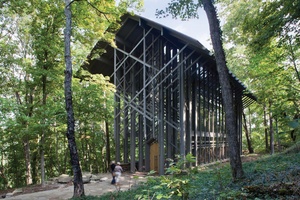
I was told a story of an aging Frank Lloyd Wright visiting a first house by one of his apprentices, a young Fay Jones. Wright apparently stood out front and critiqued with the use of his cane: “My buildings do this (waving left to right), yours do this (waving up and down). Keep going with it!” Touring the Fay Jones buildings highlighted the lineage that Wright has embedded into American architecture.
Fay Jones’ work and, indeed, his triumph, Thorncrown Chapel, carry this physical stone grounding, or keystone, deep into the Arkansas woods in the manner of Taliesin West, but equally in the manner of Fallingwater or Kentuck Knob. Betsky’s question is, as you might expect, a good one.
Taliesin West is, of course, amazing, as are the lifers to Wright’s work who still occupy it. But, say what you will about the Utopian principles of Taliesin West, or Paolo Soleri’s nearby Arcosanti, the suburban dream is clearly winning. Taliesin West may have, originally, been a day’s horse ride from town but it is quickly being encircled by Scottsdale suburbia.
The analogy to Mies’ Farnsworth House and its landscape shifting can be applied here, too. Wright’s desert landscape is simply shrinking. Much of the encampment’s canvas roofs and timber beams have long since been replaced with steel and plexiglass but, at some point, the stone keystones will also need to change. Not even Wright could control the landscape; the coyotes we saw were on roads.
What of the roads – part of the American landscape? Everything turns big in America. Little roads increase in size and, before you know it, you’re on the freeway. These vast lanes of asphalt sew the suburbs together like a patchwork quilt to form the great new American city. The approach isn’t new to us, though; we are, as Wright might label, ‘apprentices’ to all this. Car parks, food and retail – everything is as abundant as is the grits for breakfast. “Y’all eat like that round here, boy, y’all blow away!” was a memorable and all-too-frequent quote. No need to walk out here. The only pedestrian we saw in three days in Phoenix was someone who looked like they had got off the bus in the wrong spot and was none too happy about it.
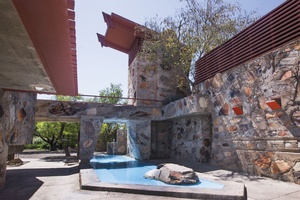
And behind the conveniences are the houses. It really is Keith Krumwiede’s Atlas of Another America.5 Krumwiede’s portrayal of huge and identical suburban houses satirically drawn into famous American landscape paintings is, unfortunately, all too familiar. American writer Alexandra Lange’s recent description of New Zealand and our architecture being “not a strange land but a version of our own”6 is unnervingly apparent, just without the coyotes and the scale that America presents.
But it is not all McMansions and a sea of beige. There’s quirk in there if you look. Marlon Blackwell Architects is wonderfully challenging the suburban dream of living, working, buying lunch and even visiting the doctor, in buildings that all look like houses. His buildings in this Freeway City are, as he puts it, “more fried eggs in a world of scrambled”.
They aren’t so much up and down like Fay Jones’ or horizontal like Wright’s, but carapaces that saddle, hoop and kick to control space and light. Yet, Blackwell designs these with both pragmatism and joy, providing generosity in spirit and contribution to their communities without any of the cover-it-all, or even cover-it-all-the-same mentality, so abundant elsewhere.
Shelby Farms Park Visitor Center in Memphis isn’t just fancy grating; it is shaped to move air with surely the biggest porch fans anywhere. But the TowerHouse, St. Nicholas Church, and the Fay Jones School of Architecture and Design building in Fayetteville, Arkansas, were no less uplifting in re-contextualising different kinds of form with their communities and landscapes.

But, it’s a long way back from freeways and suburbia to repopulating actual cities as Americans are now discovering. They’ve gone the full Elvis; Memphis may have the world’s best airport music, B.B. King bars, great hotels and Gus’s World Famous Fried Chicken, but it has very few downtown shops. Buying cowboy boots didn’t happen in Beale Street; that’s out there in the Freeway City.
Talking about buildings changing was topical, though, for just about every university had a study programme looking at how to repopulate cities, be they Wichita, Lexington or Pittsburgh. Clearly, there’s no such problem populating stadiums, for each university, no matter its size, seemed to have a 75,000-seat stadium! But the change in approach to cities was already evident in places like Birmingham, Alabama, where grand brick buildings had been refinished to attract life back downtown – people, museums, galleries, food and, of course, the music, which plays everywhere down south. This is all starting to feel like a soundtrack to life in the city. They’ll have a cowboy boot shop before you know it.
These efforts to refinish buildings weren’t limited to city buildings either. The consumer American may buy and throw away houses like they throw away cars, but Rural Studio’s work a few hours’ drive away in Hale County, Alabama, actively looks to make a change. Affordable housing that holds its value instead of quickly depreciating trailers, repurposed materials and community buildings: there is compassion with beautiful care and effect.
Just as we saw in Blackwell’s work, here is architecture participating with the needs of its community and landscape. And, in that way, their buildings are better placed to be refinished, if, or rather when, their landscapes shift; their keystone is their connection to the community, which provides another answer to Betsky’s question.
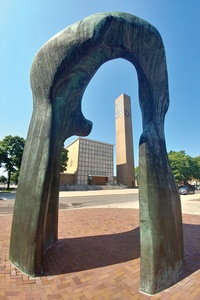
If you don’t know what’s coming, look to what is important in your fit to the landscape for prompts to change. We, of course, knew that more trees were coming and could prepare Bach with Two Roofs accordingly. It’s different outside the forest but you can still look for connections in order to maintain a fit in the future.
We saw this through Kelly Wilson’s recent unravelling of I.M. Pei’s Columbus Library’s intricate spatial fit to the city in Columbus, Indiana. The library’s connection to the city is coerced to Eliel Saarinen’s 1938 First Christian Church and, in turn, the city, through a Henry Moore sculpture and a piazza on what used to be a street. Freeway no more! This little modernist city is linked by views and movement shafts rather than asphalt – buildings that are talking and participating with each other. Being aware that architectural change is something that affects your neighbours means buildings can be designed to look to each other for help when their landscapes shift.
This notion of participating with existing landscapes was also in discussions with Kai-Uwe Bergmann from Bjarke Ingels Group (BIG), who hosted me in New York for the final lecture: a sell-out on Broadway (albeit in a small New Zealand-sized venue). BIG’s work is big, yet progresses from a start point of understanding existing context. You can’t begin to think about how to protect Manhattan from sea-level rise without considering how you build buildings and what happens to the ones you have.
So, home with suitcases full of architectural lessons and the knowledge that our work and thinking way down here was so wonderfully received and placed into America. They are Grand Central Station but it makes me wonder why we continue to place our buildings into the work of architects who visit New Zealand. All part of that island thing, perhaps, but we might learn from America and, occasionally, place them into us. “The grass is always greener,” as one professor said to me. “It’s just that yours is pretty green.” Thank y’all for having me.
This article first appeared in Architecture New Zealand magazine.

1 The Architecture of Glenn Murcutt English and Japanese edition (Tokyo: Toto, 2015)
2 Christian Norberg-Schulz, “Talks with Mies Van Der Rohe”, L’Architecture d’aujourd’hui 29, no. 79 (1958): 100
3 Fred Bernstein, “Farnsworth House Could Soon Get A Lift”, Architecture Record (16 May 2014). archrecord.com/articles/3144-farnsworth-house-could-soon-get-a-lift
4 Vincent Scully Jr., The Shingle Style: Architectural Theory and Design from Richardson to the Origins of Wright (New Haven: Yale University Press, 1971)
5 Keith Krumwiede, Atlas of Another America: An Architectural Fiction (Zürich: Park Books, 2016)
6 Alexandra Lange, Kiwi’s Big Holiday (31 March 2016). curbed.com/2016/3/31/11326420/newzealand-architecture-tourism-alexandra-lange

